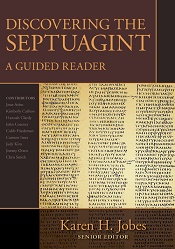 Early on, students of New Testament Greek learn that the Greek of the New Testament is only one kind of Greek worth learning when it comes to reading the Bible. Learning classical Greek will open your eyes to a larger vocabulary but dabbling in translating the Septuagint (Greek translation of the Old Testament) will necessarily expand your strengthen your Greek skills and open your eyes to another aspect of the world of biblical interpretation.
Early on, students of New Testament Greek learn that the Greek of the New Testament is only one kind of Greek worth learning when it comes to reading the Bible. Learning classical Greek will open your eyes to a larger vocabulary but dabbling in translating the Septuagint (Greek translation of the Old Testament) will necessarily expand your strengthen your Greek skills and open your eyes to another aspect of the world of biblical interpretation.
Having already coauthored, along with Moisés Silva, Invitation to the Septuagint, 2nd Ed., Karen H. Jobes, author of the highly recommended commentary 1 Peter (BECNT), has edited Septuagint Discovering the Septuagint: A Guided Reader (Kregel, 2016). Given its aim, this book does not cover the entire LXX but rather selects two to six sections from nine books in the Old Testament in order to provide the student with a variety of genres to translate from.
The outline of the book and chapters is fairly simple. There is a brief introduction to each book of the Bible from which the selections are taken. This introduction is not a typical introduction about the books contents but rather about the background of its translation from Hebrew to Greek including any challenges and peculiarities translating the book presents. Following the introduction is a verse-by-verse, with word-by-word and phrase-by-phrase, translation of the selected texts. The Greek is drawn from the Rahlfs-Hanhart critical edition of the LXX and the editors provide the New English Translation of the Septuagint (NETS) translation at the end of each section, noting where they diverge at times. There is also a short section at the end of each NETS translation charting citations and significant allusions of the covered text in the New Testament. While citations are pretty easy to identify, allusions can be illusive and translators will differ on when there is and isn’t one in a text. I personally think allusions in Romans 1:18-32 to Genesis 1 were missed in the first section of the book.
The shining mark of this book is that it was written with students in mind. All of the contributors were either students of or teaching aids/assistants to Jobes while she developed the material for the book. This is a book that serves the reader because it solicited its intended audience for ways in which the book would be most helpful to them.
The only drawback to this book is its lack of interaction with the underlying Hebrew text to the Greek translation itself. Rahlfs-Hanhart’s critical edition of the LXX is itself a translation and this book is essentially supporting the NETS which is a translation of a translation. Hebrew has a much more limited vocabulary than Greek and the syntax structures are different, both of which present the translator with difficulties. I think the book could have been strengthened (though it would have necessarily made it longer) if it interacted with the Hebrew to justify the Greek that was chosen in the first place. This would change definitely change the character of the book and maybe it is an idea for a different kind of book all together.
That criticism aside, Jobes and her students have developed a helpful book for students of New Testament who want to broaden their Greek skills and dabble with the LXX text. This is a great text for advanced Greek students and a helpful companion to Jobes and Silva’s Invitation to the Septuagint.
I received this book for free from Kregel for this review. I was not required to write a positive review. The opinions I have expressed are my own. I am disclosing this in accordance with the Federal Trade Commission’s 16 CFR, Part 255 : “Guides Concerning the Use of Endorsements and Testimonials in Advertising.”
Leave a comment